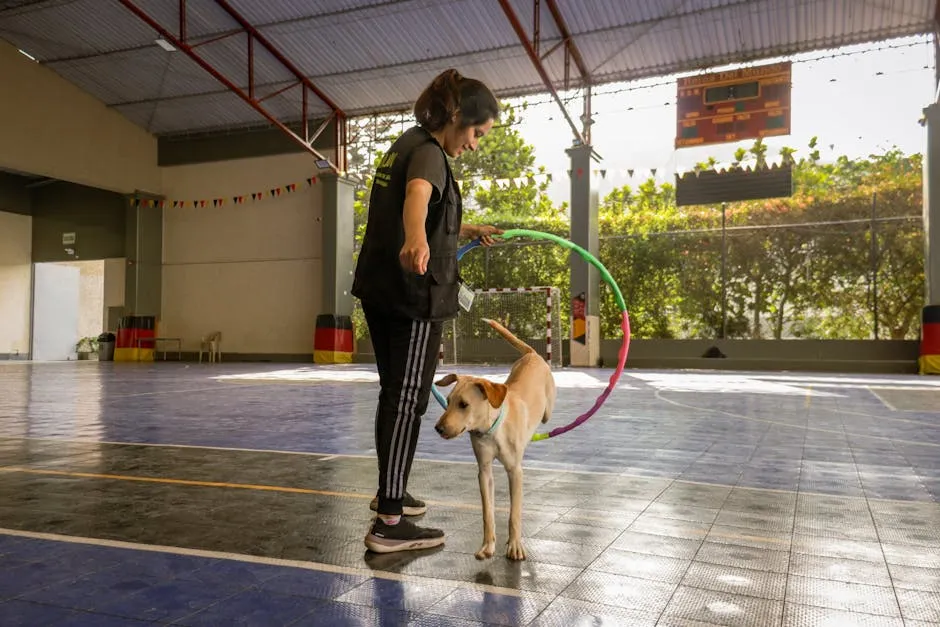Introduction
In the world of pet ownership, few things can be as rewarding—or as challenging—as training your dog. Whether you’re dealing with a playful puppy or a stubborn adult, the quest for effective dog training can feel like searching for a needle in a haystack. But fear not! With a little guidance and the right resources, you can transform your furry friend into a well-mannered companion.
Imagine this: You walk into your living room, and instead of chaos, you find a serene pup lounging peacefully. Sounds like a dream, right? The reality is that training your dog doesn’t have to be a Herculean task. With the right tools and knowledge, you can create a happy, well-adjusted canine companion who understands the rules of your home.
So, what’s the secret sauce? In this article, we’ll explore the myriad of options available for “dog training near me,” uncovering local trainers, innovative training methods, and tips for finding the best fit for your canine companion. From group classes that let your dog socialize to one-on-one sessions tailored to specific behavioral quirks, there’s something for every dog and owner. Plus, we’ll sprinkle in some success stories to keep you motivated along the way.
So grab a leash, and let’s embark on this training adventure together! Your dog is counting on you, and who knows? You might just discover a newfound bond that makes all the effort worthwhile. After all, a well-trained dog is not just a pet; they’re a cherished member of the family. Let’s get started on this journey to canine bliss!

Types of Dog Training
Obedience Training
Obedience training is the cornerstone of a well-behaved dog. It covers basic commands like sit, stay, come, and heel. Teaching these commands establishes a solid foundation for good behavior. Think of it as your dog’s etiquette class. The better your pup understands these commands, the easier it is for you to communicate and bond. Plus, who wouldn’t want a dog that doesn’t jump on guests or dart out the door?
Why is obedience training so crucial? It helps prevent unwanted behaviors and ensures your dog is safe in various situations. Imagine walking your pooch in the park and having them respond instantly to your commands. That’s the magic of good training!
If you’re looking to enhance your training sessions, consider using a Dog Training Clicker. It’s a simple tool that can significantly improve your dog’s responsiveness to commands. You’ll be amazed at how quickly they learn when you click and treat!

Behavioral Training
Behavioral training addresses specific issues like aggression and fear. If your dog tends to act out, this training can provide techniques to modify unwanted behaviors. For example, if your dog barks at strangers or shows fear when meeting other dogs, behavioral training can help. Trainers use positive reinforcement to encourage desirable behaviors while discouraging negative ones.
Socialization skills are also a vital part of behavioral training. Helping your dog learn to interact positively with others can make a big difference. Group classes offer fantastic opportunities for your furry friend to meet other dogs and humans in a controlled environment. It’s like a puppy playdate with a purpose!
And don’t forget about the importance of Dog Treats for Training. Using tasty rewards can make all the difference in keeping your pup motivated and engaged during training sessions!

Specialty Training
Specialty training focuses on specific roles and skills. This includes training service and therapy dogs, which require a unique set of skills to assist individuals with disabilities or provide comfort in therapeutic settings. These dogs undergo rigorous training to ensure they can perform their roles effectively.
Trick training is another fun aspect of specialty training. Teaching your dog tricks like rolling over, playing dead, or fetching specific items is not just entertaining; it also engages your dog mentally. It’s a great way to bond and keep your dog sharp. Plus, who doesn’t love showing off a dog that can do tricks?
If you want to dive deeper into training techniques, consider picking up a Dog Training Manual. It’s packed with valuable insights and strategies to enhance your training journey!

Finding Local Dog Trainers
Online Resources
Finding local dog trainers has never been easier thanks to online resources. Websites and apps like Wag! and Dog Training Elite allow you to browse profiles of trainers in your area. These platforms often provide ratings and reviews from other pet owners, helping you make informed decisions.
Social media groups are another excellent source for recommendations. Join local pet owner groups, and you’ll find a wealth of information. Members often share their experiences and can point you toward reputable trainers.
To keep your furry friend healthy and happy, don’t forget to have a Pet First Aid Kit handy. Accidents happen, and being prepared is always a smart move!

Vet Recommendations
Your veterinarian can be a fantastic resource when searching for dog trainers. Vets often have connections with local trainers and can recommend those who specialize in specific behavior issues. They understand your dog’s health needs and can guide you to trainers who use safe and effective methods.
Personal Referrals
Never underestimate the power of word-of-mouth recommendations. Asking fellow dog owners in your community can lead to discovering hidden gems. Whether at the dog park or a local pet store, fellow pet parents can share their training experiences and suggest trainers they trust.

Evaluating Trainers
When evaluating trainers, look for their qualifications and experience. You want someone who has a solid background in dog training and behavior. A trainer with certifications from reputable organizations typically indicates a higher level of expertise.
Trial sessions can be beneficial, too. Meeting a trainer before committing allows you to assess their approach. You can observe how they interact with your dog and whether your furry friend responds positively. This step can save you time and frustration in the long run.
By exploring various options and resources, you can find the perfect trainer for your dog’s unique needs. Remember, training is an investment in your dog’s future—and your sanity!

Training Techniques
Positive Reinforcement
Positive reinforcement is a training technique that thrives on rewards. Think of it like a doggie high-five! When your furry friend displays a desired behavior, you reward them. This encourages them to repeat that behavior. It’s all about making training fun for your pup.
So, how does it work? Simple! You catch your dog doing something right and reward them immediately. This could be sitting quietly, not barking at the mailman, or even just coming when called. The quicker the reward, the better!
Now, what kinds of rewards can you use? Treats are always a hit—who doesn’t love a good snack? Praise is another fantastic option. Your dog loves hearing you say, “Good boy!” or “You’re such a smart pup!” Toys can also be a great reward, especially for playful dogs. Just remember to keep the rewards varied. This keeps your pup interested and eager to learn.
For more information on effective positive reinforcement techniques, check out this article on effective positive reinforcement techniques for stubborn dogs.

Clicker Training
Clicker training is a popular method that employs a small device that makes a clicking sound. This click serves as a marker, indicating to your dog that they’ve done something right. It’s like your own dog training sound effect!
Using a clicker enhances communication between you and your dog. It allows for precise timing. When your dog performs the desired action, you click, then follow up with a reward. This helps your pup connect the dots more effectively.
Ready to try it at home? Here’s a step-by-step guide:
- Get a Clicker: Purchase a clicker or use a free app that mimics the sound.
- Introduce the Clicker: Click and immediately give a treat. Repeat until your dog associates the click with a reward.
- Start Training: Begin with a simple command like “sit.” Click when they sit, then reward them.
- Practice: Repeat this process regularly, gradually introducing more commands.
With patience and practice, your dog will learn to respond to the clicker like a pro!

Group Classes vs. Private Sessions
When it comes to dog training, you have options. Group classes and private sessions both have their perks. It’s essential to weigh the pros and cons of each.
Group classes are fantastic for socialization. Your dog gets to interact with other dogs, which helps reduce anxiety and improves their social skills. Plus, you benefit from the camaraderie of other dog owners. You might even make new friends!
On the flip side, group classes can be overwhelming for some dogs. If your pup is shy or anxious, they might not thrive in this setting.
Private sessions provide tailored training. Your trainer focuses solely on your dog’s individual needs. This can be especially useful for addressing specific behavioral issues. However, private sessions can be pricier, which is something to consider.
Ultimately, what’s best for your dog? Think about their personality. If they thrive in social settings, group classes could be the way to go. If they’re more reserved or have particular challenges, private training may be more effective. Choose what suits your dog’s needs best!

Cost Considerations
Average Pricing
Understanding the costs of dog training can help you budget better. Group classes usually cost less than private sessions. Group classes typically range from $30 to $50 per session. They can be an economical way to get your pup trained while socializing.
Private sessions, however, can vary widely. Expect to pay anywhere from $50 to $150 per hour. This price often reflects the trainer’s experience and the tailored approach they offer.
Watch out for hidden fees! Some training facilities charge extra for materials, or require a deposit. Be sure to clarify all costs upfront to avoid surprises later.
When budgeting for training, consider investing in a Dog Training Leash. A good leash can make training sessions smoother and more enjoyable for both you and your dog!

Budgeting for Training
Planning for dog training expenses is key to success. Start by setting a realistic budget. Consider how many sessions you feel comfortable paying for each month.
Think long-term. Investing in your dog’s training now can save you costs associated with behavioral issues later. Prioritize training that addresses your dog’s specific needs.
Additionally, look for discounted options. Some trainers offer package deals or sliding-scale fees based on income. Other resources, like community programs, might provide affordable training opportunities.
By budgeting wisely, you can ensure your furry friend gets the training they need without breaking the bank!

FAQs
What is the best age to start training my dog?
The ideal age to begin training varies by dog. Generally, starting early is beneficial. Puppies can start basic training as young as eight weeks. At this age, they absorb new information like sponges. Ongoing training is essential as your dog matures. Regular refreshers help reinforce good behavior throughout their life.
How do I know if a trainer is right for my dog?
Compatibility between your dog and the trainer is crucial. Watch how the trainer interacts with your pup during the initial meeting. Do they use positive reinforcement? Are they patient? If your dog seems at ease and responsive, that’s a good sign. Trust your instincts; if something feels off, keep looking!
Can I train my dog at home, or do I need a professional?
You can train your dog at home! Many owners successfully teach their dogs basic commands using online resources or books. However, professional training has its perks. Trainers bring expertise, structure, and can address specific behavioral issues. If you feel overwhelmed, consider hiring a pro for guidance.
What should I do if my dog isn’t responding to training?
If your dog isn’t responding, don’t panic! First, evaluate your training methods. Are you using positive reinforcement? If not, switch to it. Consistency is key. Break commands into smaller steps and practice regularly. If issues persist, consulting a professional trainer can provide fresh perspectives and techniques.
Are there any resources for low-income pet owners?
Absolutely! Many communities offer discounted training programs for low-income pet owners. Local shelters often provide affordable classes. Additionally, some trainers offer sliding scale fees based on income. Don’t hesitate to reach out and ask about financial assistance options. Your dog’s training needs are important, and support is available!
Finding Local Dog Trainers
When it comes to training your beloved pooch, finding the right trainer nearby can make all the difference. Luckily, you have a plethora of options. Let’s break it down into bite-sized pieces.

Online Resources
In this tech-savvy age, online resources are your best friend. Websites like Wag! and Dog Training Elite offer vast directories of local trainers. You can check reviews and ratings from other pet parents, which can help steer you toward the best fit. It’s like Yelp, but for your four-legged friend’s education!
Social media groups are also treasure troves of information. Join local pet owner communities and you’ll find a wealth of recommendations. The more, the merrier! Pet parents love to share their experiences, and you might discover trainers who are hidden gems in your area.
If you’re looking for a great way to keep your dog occupied while you’re busy, consider investing in Interactive Dog Toys. They’ll keep your pup entertained and mentally stimulated!

Vet Recommendations
Your veterinarian is a goldmine of information. They often have ties with local trainers and can recommend specialists for specific behavioral issues. Plus, they understand your dog’s health needs, so you know you’re getting solid advice. Don’t hesitate to ask during your next visit!
Personal Referrals
Word of mouth is powerful. Chat with fellow dog owners at the park or in your neighborhood. You might hear about trainers who have transformed rambunctious pups into well-behaved companions. Personal experiences are invaluable, and who knows? You might even make a new friend while you’re at it!

Evaluating Trainers
Once you’ve gathered a list of potential trainers, it’s time to evaluate them. Look for qualifications and experience that align with your dog’s needs. A trainer with certifications from reputable organizations is often a good sign.
Consider trial sessions, where you can observe how the trainer interacts with your dog. Is there a connection? Does your pup seem comfortable? If the answer is “yes,” then you might have found the one.
Remember, training is an investment in your dog’s future. A little research can lead to a big payoff in terms of a well-behaved, happy pup. With the right trainer, your dog will be the star of the neighborhood!
Please let us know what you think about our content by leaving a comment down below!
Thank you for reading till here 🙂
All images from Pexels





